BdNub Is Essential for Maintaining gut Immunity and Microbiome Homeostasis in Bactrocera dorsalis
Abstract
Simple Summary
Abstract
1. Introduction
2. Materials and Methods
2.1. Insects Rearing
2.2. BdNub Identification
2.3. BdNub Spatial and Temporal Expression Profiles
2.4. RNA Extraction and cDNA Synthesis
2.5. Real-Time PCR
2.6. DsRNA Synthesis and RNA Interference
2.7. Bacterial Infection and Survival Assay
2.8. Gut Bacterial DNA Extraction
2.9. Quantification of Bacterial Species or Group by qPCR
2.10. Statistics and Analysis
3. Results
3.1. Identification of Nub Gene in B. dorsalis
3.2. Temporal and Spatial Expression Patterns of the BdNub Gene
3.3. BdNub Does Not Participate in Systemic Infection of the IMD Pathway
3.4. BdNub Regulates the Expression of Gut AMPs after Oral Infection
3.5. BdNub Is Necessary to Maintain Gut Microbiota Composition and Structure
4. Discussion
Supplementary Materials
Author Contributions
Funding
Data Availability Statement
Acknowledgments
Conflicts of Interest
References
- Basset, Y.; Cizek, L.; Cuénoud, P.; Didham, R.K.; Guilhaumon, F.; Missa, O.; Novotny, V.; Ødegaard, F.; Roslin, T.; Schmidl, J.; et al. Arthropod Diversity in a Tropical Forest. Science 2012, 338, 1481–1484. [Google Scholar] [CrossRef] [PubMed]
- Engel, P.; Moran, N.A. The Gut Microbiota of Insects—Diversity in Structure and Function. FEMS Microbiol. Rev. 2013, 37, 699–735. [Google Scholar] [CrossRef] [PubMed]
- Gottar, M.; Gobert, V.; Michel, T.; Belvin, M.; Duyk, G.; Hoffmann, J.A.; Ferrandon, D.; Royet, J. The Drosophila Immune Response against Gram-Negative Bacteria Is Mediated by a Peptidoglycan Recognition Protein. Nature 2002, 416, 640–644. [Google Scholar] [CrossRef] [PubMed]
- Brennan, C.A.; Anderson, K.V. Drosophila: The Genetics of Innate Immune Recognition and Response. Annu. Rev. Immunol. 2004, 22, 457–483. [Google Scholar] [CrossRef]
- Royet, J.; Dziarski, R. Peptidoglycan Recognition Proteins: Pleiotropic Sensors and Effectors of Antimicrobial Defences. Nat. Rev. Microbiol. 2007, 5, 264–277. [Google Scholar] [CrossRef]
- Lemaitre, B.; Hoffmann, J. The Host Defense of Drosophila Melanogaster. Annu. Rev. Immunol. 2007, 25, 697–743. [Google Scholar] [CrossRef]
- Imler, J.-L.; Bulet, P. Antimicrobial Peptides in Drosophila: Structures, Activities and Gene Regulation. Mech. Epithel. Def. 2005, 86, 1–21. [Google Scholar] [CrossRef]
- Hanson, M.A.; Dostálová, A.; Ceroni, C.; Poidevin, M.; Kondo, S.; Lemaitre, B. Synergy and Remarkable Specificity of Antimicrobial Peptides in Vivo Using a Systematic Knockout Approach. eLife 2019, 8, e44341. [Google Scholar] [CrossRef]
- Horak, R.D.; Leonard, S.P.; Moran, N.A. Symbionts Shape Host Innate Immunity in Honeybees. Proc. R. Soc. B 2020, 287, 20201184. [Google Scholar] [CrossRef]
- Zhang, L.; Gallo, R.L. Antimicrobial Peptides. Curr. Biol. 2016, 26, R14–R19. [Google Scholar] [CrossRef]
- Davis, M.M.; Engström, Y. Immune Response in the Barrier Epithelia: Lessons from the Fruit Fly Drosophila Melanogaster. J. Innate Immun. 2012, 4, 273–283. [Google Scholar] [CrossRef]
- Tantin, D. Oct Transcription Factors in Development and Stem Cells: Insights and Mechanisms. Development 2013, 140, 2857–2866. [Google Scholar] [CrossRef]
- Dantoft, W.; Lundin, D.; Esfahani, S.S.; Engström, Y. The POU/Oct Transcription Factor Pdm1/Nub Is Necessary for a Beneficial Gut Microbiota and Normal Lifespan of Drosophila. J. Innate Immun. 2016, 8, 412–426. [Google Scholar] [CrossRef]
- Dantoft, W.; Davis, M.M.; Lindvall, J.M.; Tang, X.; Uvell, H.; Junell, A.; Beskow, A.; Engström, Y. The Oct1 Homolog Nubbin Is a Repressor of NF-ΚB-Dependent Immune Gene Expression That Increases the Tolerance to Gut Microbiota. BMC Biol. 2013, 11, 99. [Google Scholar] [CrossRef]
- Lindberg, B.G.; Tang, X.; Dantoft, W.; Gohel, P.; Seyedoleslami Esfahani, S.; Lindvall, J.M.; Engström, Y. Nubbin Isoform Antagonism Governs Drosophila Intestinal Immune Homeostasis. PLoS Pathog. 2018, 14, e1006936. [Google Scholar] [CrossRef]
- Dillon, R.J.; Dillon, V.M. THE GUT B ACTERIA OF INSECTS: Nonpathogenic Interactions. Annu. Rev. Entomol. 2004, 49, 71–92. [Google Scholar] [CrossRef]
- Consuegra, J.; Grenier, T.; Baa-Puyoulet, P.; Rahioui, I.; Akherraz, H.; Gervais, H.; Parisot, N.; da Silva, P.; Charles, H.; Calevro, F.; et al. Drosophila-Associated Bacteria Differentially Shape the Nutritional Requirements of Their Host during Juvenile Growth. PLoS Biol. 2020, 18, e3000681. [Google Scholar] [CrossRef]
- Storelli, G.; Strigini, M.; Grenier, T.; Bozonnet, L.; Schwarzer, M.; Daniel, C.; Matos, R.; Leulier, F. Drosophila Perpetuates Nutritional Mutualism by Promoting the Fitness of Its Intestinal Symbiont Lactobacillus Plantarum. Cell Metab. 2018, 27, 362–377.e8. [Google Scholar] [CrossRef]
- Flórez, L.V.; Scherlach, K.; Gaube, P.; Ross, C.; Sitte, E.; Hermes, C.; Rodrigues, A.; Hertweck, C.; Kaltenpoth, M. Antibiotic-Producing Symbionts Dynamically Transition between Plant Pathogenicity and Insect-Defensive Mutualism. Nat. Commun. 2017, 8, 15172. [Google Scholar] [CrossRef]
- Cai, Z.; Yao, Z.; Li, Y.; Xi, Z.; Bourtzis, K.; Zhao, Z.; Bai, S.; Zhang, H. Intestinal Probiotics Restore the Ecological Fitness Decline of Bactrocera Dorsalis by Irradiation. Evol. Appl. 2018, 11, 1946–1963. [Google Scholar] [CrossRef]
- Yao, Z.; Wang, A.; Li, Y.; Cai, Z.; Lemaitre, B.; Zhang, H. The Dual Oxidase Gene BdDuox Regulates the Intestinal Bacterial Community Homeostasis of Bactrocera Dorsalis. ISME J. 2016, 10, 1037–1050. [Google Scholar] [CrossRef] [PubMed]
- Broderick, N.A.; Buchon, N.; Lemaitre, B. Microbiota-Induced Changes in Drosophila Melanogaster Host Gene Expression and Gut Morphology. mBio 2014, 5, e01117-14. [Google Scholar] [CrossRef] [PubMed]
- Yao, Z.; Cai, Z.; Ma, Q.; Bai, S.; Wang, Y.; Zhang, P.; Guo, Q.; Gu, J.; Lemaitre, B.; Zhang, H. Compartmentalized PGRP Expression along the Dipteran Bactrocera Dorsalis Gut Forms a Zone of Protection for Symbiotic Bacteria. Cell Rep. 2022, 41, 111523. [Google Scholar] [CrossRef] [PubMed]
- Raza, M.F.; Wang, Y.; Cai, Z.; Bai, S.; Yao, Z.; Awan, U.A.; Zhang, Z.; Zheng, W.; Zhang, H. Gut Microbiota Promotes Host Resistance to Low-Temperature Stress by Stimulating Its Arginine and Proline Metabolism Pathway in Adult Bactrocera Dorsalis. PLoS Pathog. 2020, 16, e1008441. [Google Scholar] [CrossRef] [PubMed]
- Guo, Q.; Yao, Z.; Cai, Z.; Bai, S.; Zhang, H. Gut Fungal Community and Its Probiotic Effect on Bactrocera Dorsalis. Insect Sci. 2022, 29, 1145–1158. [Google Scholar] [CrossRef]
- Livak, K.J.; Schmittgen, T.D. Analysis of Relative Gene Expression Data Using Real-Time Quantitative PCR and the 2\textbackslashtextminusΔΔCT Method. Methods 2001, 25, 402–408. [Google Scholar] [CrossRef]
- Guo, X.; Xia, X.; Tang, R.; Wang, K. Real-Time PCR Quantification of the Predominant Bacterial Divisions in the Distal Gut of Meishan and Landrace Pigs. Anaerobe 2008, 14, 224–228. [Google Scholar] [CrossRef]
- Bartosch, S.; Fite, A.; Macfarlane, G.T.; McMurdo, M.E.T. Characterization of Bacterial Communities in Feces from Healthy Elderly Volunteers and Hospitalized Elderly Patients by Using Real-Time PCR and Effects of Antibiotic Treatment on the Fecal Microbiota. Appl. Environ. Microbiol. 2004, 70, 3575–3581. [Google Scholar] [CrossRef]
- Rinttila, T.; Kassinen, A.; Malinen, E.; Krogius, L.; Palva, A. Development of an Extensive Set of 16S RDNA-Targeted Primers for Quantification of Pathogenic and Indigenous Bacteria in Faecal Samples by Real-Time PCR. J. Appl. Microbiol. 2004, 97, 1166–1177. [Google Scholar] [CrossRef]
- Abell, G.C.J.; Bowman, J.P. Ecological and Biogeographic Relationships of Class Flavobacteria in the Southern Ocean. Fems Microbiol. Ecol. 2005, 51, 265–277. [Google Scholar] [CrossRef]
- Ahmed, W.; Huygens, F.; Goonetilleke, A.; Gardner, T. Real-Time PCR Detection of Pathogenic Microorganisms in Roof-Harvested Rainwater in Southeast Queensland, Australia. Appl. Environ. Microbiol. 2008, 74, 5490–5496. [Google Scholar] [CrossRef]
- Matsuda, K.; Tsuji, H.; Asahara, T.; Matsumoto, K.; Takada, T.; Nomoto, K. Establishment of an Analytical System for the Human Fecal Microbiota, Based on Reverse Transcription-Quantitative PCR Targeting of Multicopy RRNA Molecules. Appl. Environ. Microbiol. 2009, 75, 1961–1969. [Google Scholar] [CrossRef]
- Bürglin, T.R.; Affolter, M. Homeodomain Proteins: An Update. Chromosoma 2016, 125, 497–521. [Google Scholar] [CrossRef]
- Tang, X.; Engström, Y. Regulation of Immune and Tissue Homeostasis by Drosophila POU Factors. Insect Biochem. Mol. Biol. 2019, 109, 24–30. [Google Scholar] [CrossRef]
- Cifuentes, F.J.; García-Bellido, A. Proximo–Distal Specification in the Wing Disc of Drosophila by the Nubbin Gene. Proc. Natl. Acad. Sci. USA 1997, 94, 11405–11410. [Google Scholar] [CrossRef]
- Poliacikova, G.; Maurel-Zaffran, C.; Graba, Y.; Saurin, A.J. Hox Proteins in the Regulation of Muscle Development. Front. Cell Dev. Biol. 2021, 9, 731996. [Google Scholar] [CrossRef]
- Paul, R.; Giraud, G.; Domsch, K.; Duffraisse, M.; Marmigère, F.; Khan, S.; Vanderperre, S.; Lohmann, I.; Stoks, R.; Shashidhara, L.S.; et al. Hox Dosage Contributes to Flight Appendage Morphology in Drosophila. Nat. Commun. 2021, 12, 2892. [Google Scholar] [CrossRef]
- Mallo, M. Reassessing the Role of Hox Genes during Vertebrate Development and Evolution. Trends Genet. 2018, 34, 209–217. [Google Scholar] [CrossRef]
- Fernandez-Nicolas, A.; Ventos-Alfonso, A.; Kamsoi, O.; Clark-Hachtel, C.; Tomoyasu, Y.; Belles, X. Broad Complex and Wing Development in Cockroaches. Insect Biochem. Mol. Biol. 2022, 147, 103798. [Google Scholar] [CrossRef]
- Ng, M.; Diaz-Benjumea, F.J.; Cohen, S.M. Nubbin Encodes a POU-Domain Protein Required for Proximal-Distal Patterning in the Drosophila Wing. Development 1995, 121, 589–599. [Google Scholar] [CrossRef]
- Zirin, J.D.; Mann, R.S. Nubbin and Teashirt Mark Barriers to Clonal Growth along the Proximal–Distal Axis of the Drosophila Wing. Dev. Biol. 2007, 304, 745–758. [Google Scholar] [CrossRef] [PubMed]
- Neumann, C.J.; Cohen, S.M. Boundary Formation in Drosophila Wing: Notch Activity Attenuated by the POU Protein Nubbin. Science 1998, 281, 409–413. [Google Scholar] [CrossRef] [PubMed]
- Buddika, K.; Huang, Y.-T.; Ariyapala, I.S.; Butrum-Griffith, A.; Norrell, S.A.; O’Connor, A.M.; Patel, V.K.; Rector, S.A.; Slovan, M.; Sokolowski, M.; et al. Coordinated Repression of Pro-Differentiation Genes via P-Bodies and Transcription Maintains Drosophila Intestinal Stem Cell Identity. Curr. Biol. 2022, 32, 386–397.e6. [Google Scholar] [CrossRef] [PubMed]
- Kleino, A.; Myllymäki, H.; Kallio, J.; Vanha-aho, L.-M.; Oksanen, K.; Ulvila, J.; Hultmark, D.; Valanne, S.; Rämet, M. Pirk Is a Negative Regulator of the Drosophila Imd Pathway. J. Immunol. 2008, 180, 5413–5422. [Google Scholar] [CrossRef] [PubMed]
- Mellroth, P.; Steiner, H. akan PGRP-SB1: An N-Acetylmuramoyl l-Alanine Amidase with Antibacterial Activity. Biochem. Biophys. Res. Commun. 2006, 350, 994–999. [Google Scholar] [CrossRef] [PubMed]
- Zaidman-Rémy, A.; Hervé, M.; Poidevin, M.; Pili-Floury, S.; Kim, M.-S.; Blanot, D.; Oh, B.-H.; Ueda, R.; Mengin-Lecreulx, D.; Lemaitre, B. The Drosophila Amidase PGRP-LB Modulates the Immune Response to Bacterial Infection. Immunity 2006, 24, 463–473. [Google Scholar] [CrossRef]
- Joga, M.R.; Zotti, M.J.; Smagghe, G.; Christiaens, O. RNAi Efficiency, Systemic Properties, and Novel Delivery Methods for Pest Insect Control: What We Know So Far. Front. Physiol. 2016, 7, 553. [Google Scholar] [CrossRef]
- Araujo, R.N.; Santos, A.; Pinto, F.S.; Gontijo, N.F.; Lehane, M.J.; Pereira, M.H. RNA Interference of the Salivary Gland Nitrophorin 2 in the Triatomine Bug Rhodnius Prolixus (Hemiptera: Reduviidae) by DsRNA Ingestion or Injection. Insect Biochem. Mol. Biol. 2006, 36, 683–693. [Google Scholar] [CrossRef]
- Ryu, J.-H.; Kim, S.-H.; Lee, H.-Y.; Bai, J.Y.; Nam, Y.-D.; Bae, J.-W.; Lee, D.G.; Shin, S.C.; Ha, E.-M.; Lee, W.-J. Innate Immune Homeostasis by the Homeobox Gene Caudal and Commensal-Gut Mutualism in Drosophila. Science 2008, 319, 777–782. [Google Scholar] [CrossRef]
- Wang, H.; Jin, L.; Zhang, H. Comparison of the Diversity of the Bacterial Communities in the Intestinal Tract of Adult Bactrocera Dorsalis from Three Different Populations. J. Appl. Microbiol. 2011, 110, 1390–1401. [Google Scholar] [CrossRef]
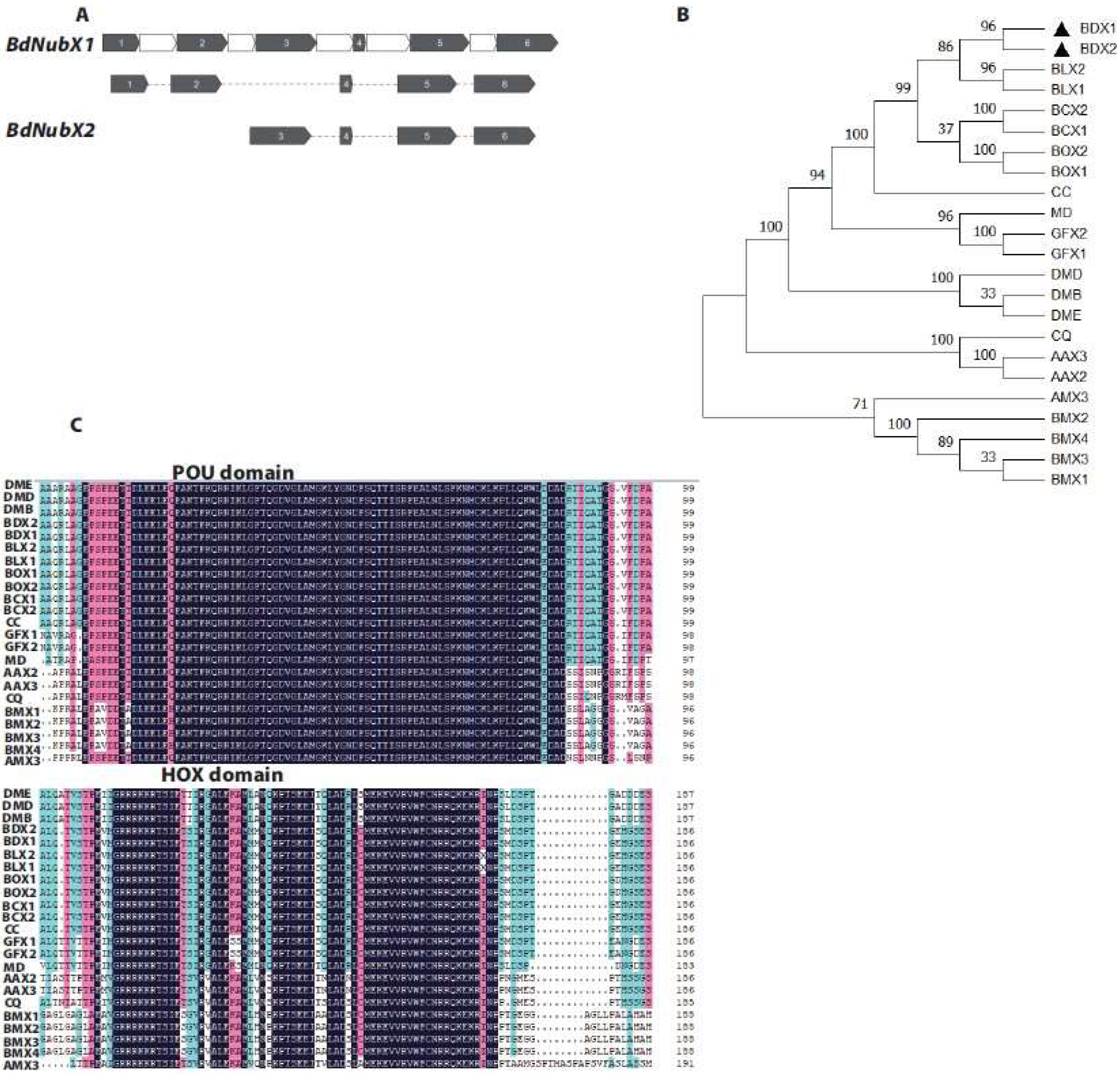
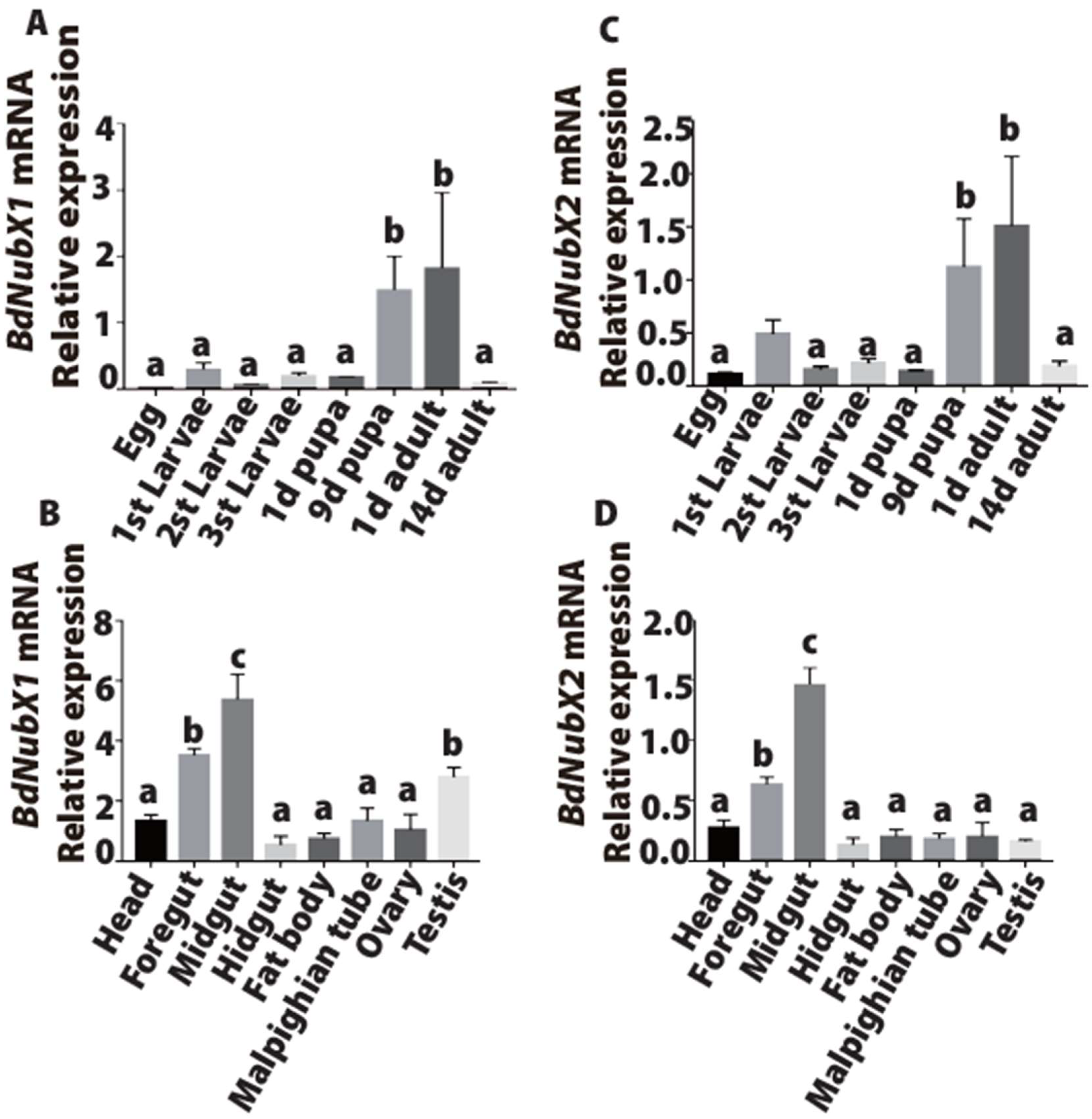
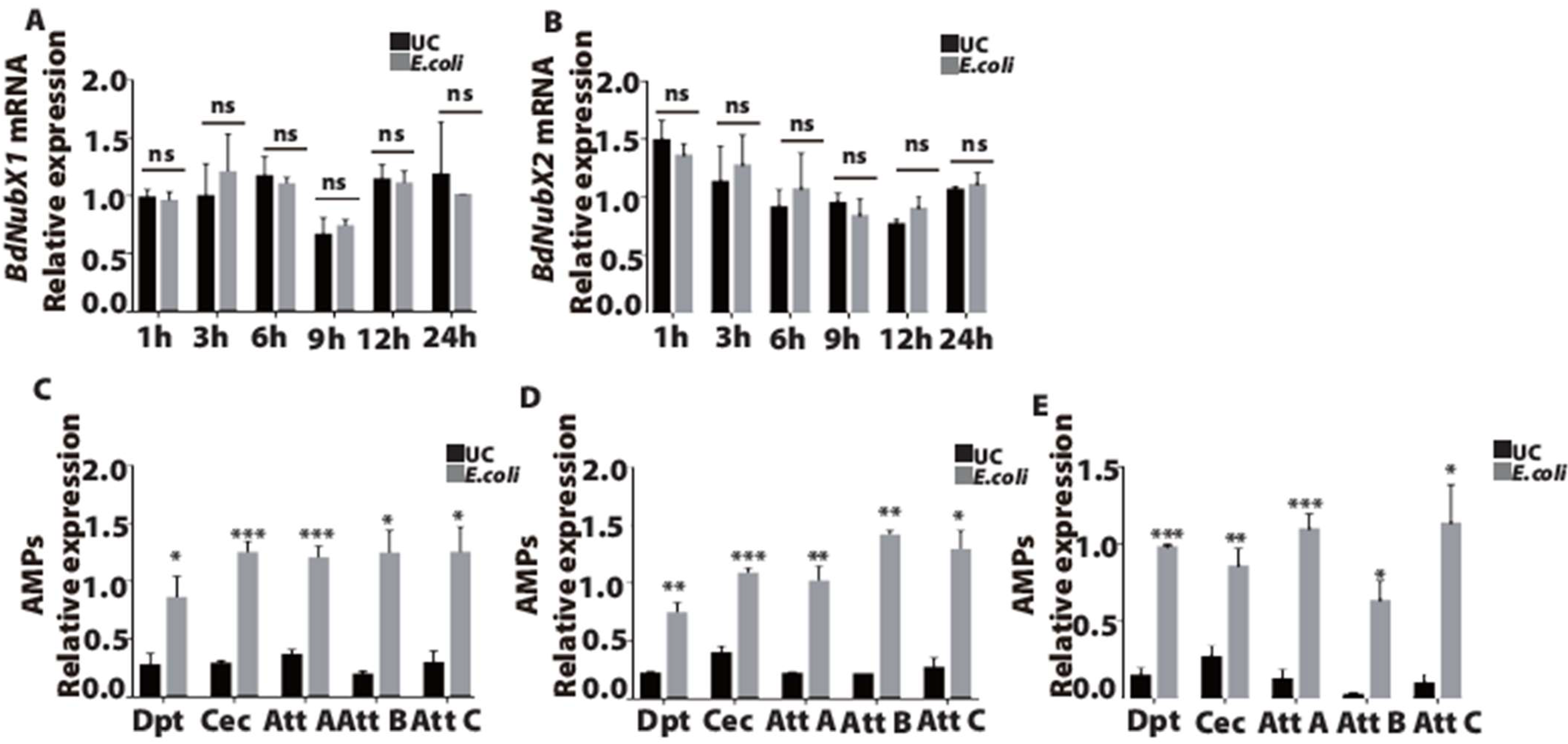
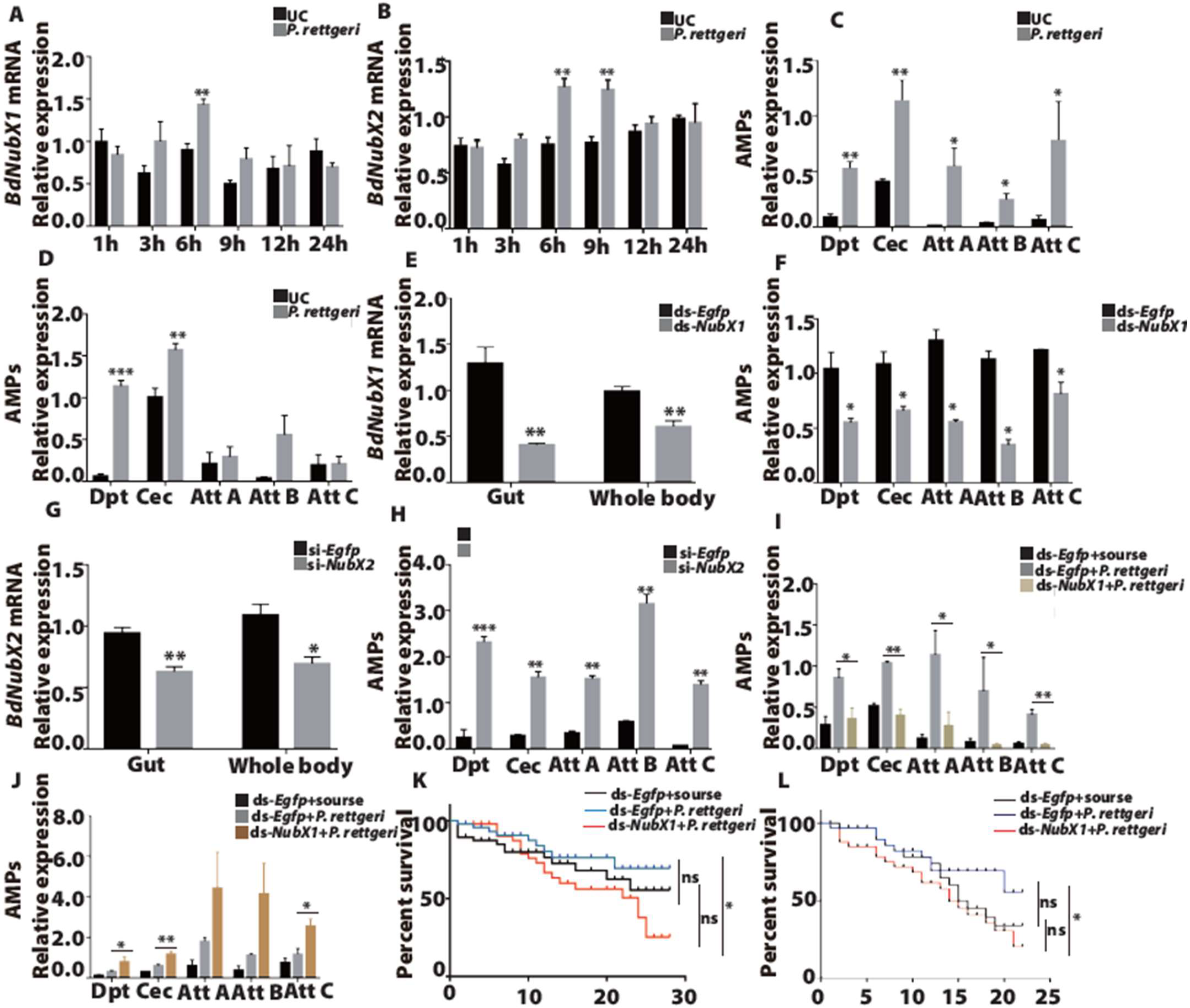
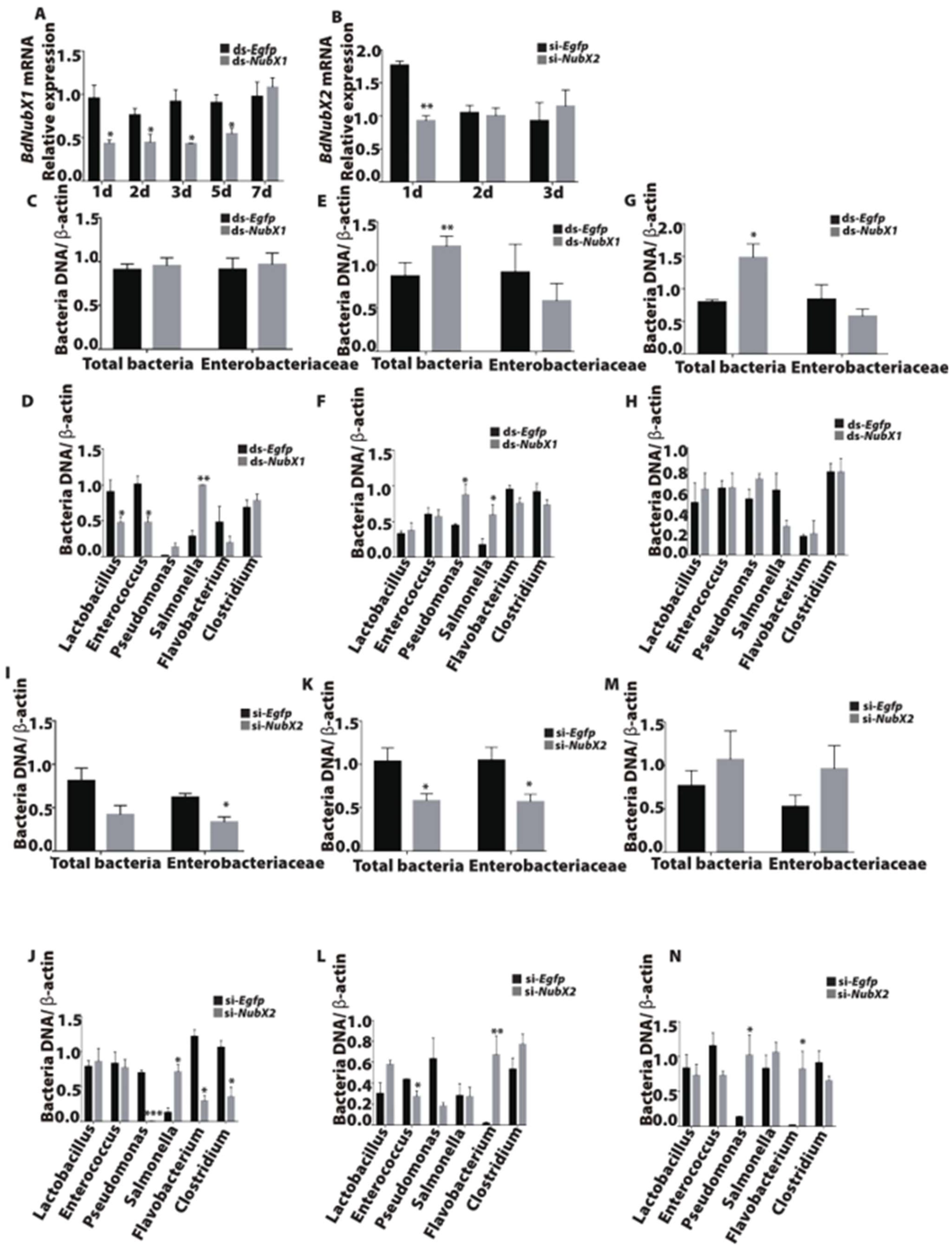
| Primer Name | Sequence | Target Gene | Amplicon Size (bp) |
|---|---|---|---|
| QRpl32 F | 5′-CCCGTCATATGCTGCCAACT-3′ | Rpl32 | 148 bp |
| QRpl32 R | 5′-GCGCGCTCAACAATTTCCTT-3′ | ||
| QBdNubX1 F | 5′-GCAGTAATGTGCCCCAGAAG-3′ | NubX1 | 115 bp |
| QBdNubX1 R | 5′-AACGCAGACGTAGCGGTAAC-3′ | ||
| QBdNubX2 F | 5′-GTCGAGCATCGAGGTGTTTT-3′ | NubX2 | 105 bp |
| QBdNubX2 R | 5′-AGTGTCTGAGCGCTTGTGTG-3′ | ||
| QBdDpt F | 5′-GCATAGATTTGAGCCTTGACACAC-3′ | Diptcin | 110 bp |
| QBdDpt R | 5′-GCCATATCGTCCGCCCAAAT-3′ | ||
| QBdCec F | 5′-GGCAAGAAAATTGAGCGGGT-3′ | Cecropin | 100 bp |
| QBdCec R | 5′-CCTTCAATGTTGCTGCCACA-3′ | ||
| QBdAttA F | 5′-GTGGCAACCTTAATTGGGCG-3′ | Attcin A | 106 bp |
| QBdAttA R | 5′-AGATTGGAACTTGCGCCGTA-3′ | ||
| QBdAttB F | 5′-ACACGCTTGGACTTGACAGG-3′ | Attcin B | 93 bp |
| QBdAttB R | 5′-ATGAGTCAATCCCAAGCCGG-3′ | ||
| QBdAttC F | 5′-GAGTTGGCCGGTAGAGCAAA-3′ | Attcin C | 104 bp |
| QBdAttC R | 5′-GTAGTCGCGTTGTCCACTCA-3′ | ||
| QBdDef F | 5′-CTGGAAAAGTCAATGGGCCG-3′ | Defensin | 105 bp |
| QBdDef R | 5′-AAGCGATACAATGGACAGCG-3′ | ||
| QBdactinF | 5′-TCGATCATGAAGTGCGATGT-3 | β-actin | 101 bp |
| QBdactinR | 5′-ATCAGCAATACCGGGGTACA-3 |
| BdNubX1 T7F | 5′-GGATCCTAATACGACTCACTATAGGACCAGGCATTTTGAACCCA-3′ |
| BdNubX1 T7R | 5′-GGATCCTAATACGACTCACTATAGGTGATCCGCTGACTCCGTCT-3′ |
| Egfp T7F | 5′-GGATCCTAATACGACTCACTATAGGACGTAAACGGCCACAAGTTC-3 |
| Egfp T7R | 5′-GGATCCTAATACGACTCACTATAGGAAGTCGTGCTGCTTCATGTG-3′ |
| Si-BdNubX2 | 5′-GTGGGCACATAATGCAGAA-3′ |
| Target Bacteria | Primer Name | Sequence | Resources | Target Gene | Amplicon Size (bp) |
|---|---|---|---|---|---|
| Total bacteria | Tol F | 5′-TCCTACGGGAGGCAGCAGT-3′ | (Guo et al., 2008) [23,27] | 16S RNA | 466 bp |
| Tol R | 5′-GGACTACCAGGGTATCTATCCTGTT-3′ | ||||
| Enterobacteriaceae | Ent F | 5′-CATTGACGTTACCCGCAGAAGAAGC-3′ | (Bartosch et al., 2004) [23,28] | 16S RNA | 195 bp |
| Ent R | 5′-CTCTACGAGACTCAAGCTTGC-3′ | ||||
| Enterococcus | Eco F | 5′-CCCTTATTGTTAGTTGCCATCATT-3 | (Rinttilä et al., 2004) [29] | 16S RNA | 144 bp |
| Eco R | 5′-ACTCGTTGTACTTCCCATTGT-3′ | ||||
| Lactobacillus | Lac F | 5′-AGCAGTAGGGAATCTTCCA-3′ | (Rinttilä et al., 2004) [29] | 16S RNA | 341 bp |
| Lac R | 5′-CACCGCTACACATGGAG-3′ | ||||
| Flavobacterium | Flavo F | 5′-ATTGGGTTTAAAGGGTCC-3′ | (Abell et al., 2005) [30] | 16SRNA | 349 bp |
| Flavo R | 5′-CCGTCAATTCCTTTGAGTTT-3′ | ||||
| Salmonella | Salmon F | 5′-ACAGTGCTCGTTTACGACCTGAAT-3′ | (Ahmed et al., 2008) [31] | invA | 244 bp |
| Salmon R | 5′-AGACGACTGGTACTGATCGATAAT-3′ | ||||
| Pseudomonas | Pseudo F | 5′-CAAAACTACTGAGCTAGAGTACG-3′ | (Matsuda et al., 2009) [32] | 16S RNA | 215 bp |
| Pseudo R | 5′-TAAGATCTCAAGGATCCCAACGGCT-3′ | ||||
| Clostridium | Cclos F | 5′-AATCTTGATTGACTGAGTGGCGGAC-3′ | (Bartosch et al., 2004) [28] | 16S RNA | 148 bp |
| Cclos R | 5′-CCATCTCACACTACCGGAGTTTTTC-3′ |
Disclaimer/Publisher’s Note: The statements, opinions and data contained in all publications are solely those of the individual author(s) and contributor(s) and not of MDPI and/or the editor(s). MDPI and/or the editor(s) disclaim responsibility for any injury to people or property resulting from any ideas, methods, instructions or products referred to in the content. |
© 2023 by the authors. Licensee MDPI, Basel, Switzerland. This article is an open access article distributed under the terms and conditions of the Creative Commons Attribution (CC BY) license (https://creativecommons.org/licenses/by/4.0/).
Share and Cite
Gu, J.; Zhang, P.; Yao, Z.; Li, X.; Zhang, H. BdNub Is Essential for Maintaining gut Immunity and Microbiome Homeostasis in Bactrocera dorsalis. Insects 2023, 14, 178. https://doi.org/10.3390/insects14020178
Gu J, Zhang P, Yao Z, Li X, Zhang H. BdNub Is Essential for Maintaining gut Immunity and Microbiome Homeostasis in Bactrocera dorsalis. Insects. 2023; 14(2):178. https://doi.org/10.3390/insects14020178
Chicago/Turabian StyleGu, Jian, Ping Zhang, Zhichao Yao, Xiaoxue Li, and Hongyu Zhang. 2023. "BdNub Is Essential for Maintaining gut Immunity and Microbiome Homeostasis in Bactrocera dorsalis" Insects 14, no. 2: 178. https://doi.org/10.3390/insects14020178
APA StyleGu, J., Zhang, P., Yao, Z., Li, X., & Zhang, H. (2023). BdNub Is Essential for Maintaining gut Immunity and Microbiome Homeostasis in Bactrocera dorsalis. Insects, 14(2), 178. https://doi.org/10.3390/insects14020178







